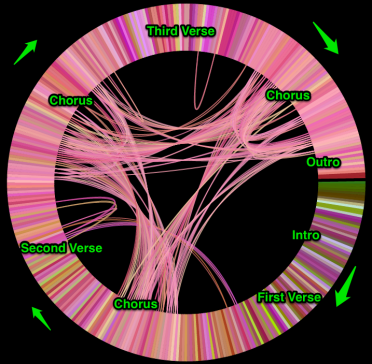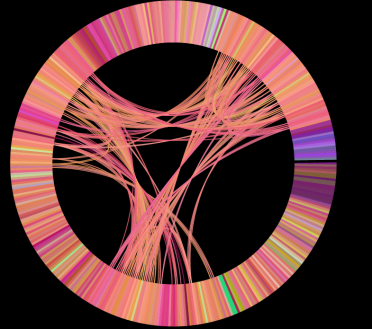The Infinite Jukebox generates plots of songs in which the most similar beats are connected by arcs. I call these plots cantograms. For instance, below is a labeled cantogram for the song Rolling in the Deep by Adele. The song starts at 3:00 on the circle and proceeds clockwise, beat by beat completely around the circle. I’ve labeled the plot so you can see how it aligns with the music. There’s an intro, a first verse, a chorus, a second verse, etc. until the outro and the end of the song.
One thing that’s interesting is that most of the beat similarity connections occur between the beats in the three instances of the chorus. This certainly makes intuitive sense. The verses have different lyrics, so for the most part they won’t be too similar to each other, but the choruses have the same lyrics, the same harmony, the same instrumentation. They may even be, for all we know may even be exactly the same audio, that perfect performance, cut and pasted three times by the audio engineer to make the best sounding version of the song.
Now take a look at the cantogram for another popular song. The plot below shows the beat similarities for the song Tik Tok by Ke$ha. What strikes me the most about this plot is how similar it looks to the plot for Rolling in the Deep. It has the characteristic longer intro+first verse, some minor inter-verse similarities and the very strong similarities between the three choruses.
As we look at more plots for modern pop music we see the same pattern over and over again. In this plot for Lady Gag’s Paparazzi a cantogram we again see the same pattern.
We see it in the plot for Justin Bieber’s Baby:
Taylor Swift’s Fearless has a two verses before the first chorus, shifting it further around the circle, but other than that the pattern holds:
Now compare and contrast the pop cantograms with those from other styles of music. First up is Led Zeppelin’s Stairway to heaven. There’s no discernable repeating chorus, or global song repetition, the only real long-arc repetition occurs during the guitar solo for the last quarter of the song.
Here’s another style of music. Deadmau5’s Raise your weapon. This is electronica (and maybe some dubstep). Clearly from the cantogram we can see that is is not a traditional pop song. Very little long arc repetition, with the densest cluster being the final dubstep break.
Dave Brubeck’s Take Five has a very different pattern, with lots of short term repetition during the first half of the song, while during the second half with Joe Morello’s drum solo there’s a very different pattern.
Green Grass and High Tides has yet a different pattern – no three choruses and out here. (By the way, the final guitar solo is well worth listening to in the Infinite Jukebox. It is the guitar solo that never ends).
The progressive rock anthem Roundabout doesn’t have the Pop Pattern
Nor does Yo-Yo Ma’s performance of the Cello suite No. 1.
Looking at the pop plots one begins to understand that pop music really could be made in a factory. Each song is cut from the same mold. In fact, one of the most successful pop songs in recent years, was produced by a label with factory in its name. Looking at Rebecca Black’s Friday we can tell right away that it is a pop song:
Compare that plot to this years Youtube breakout, Thanksgiving by Nicole Westbrook, (another Ark Music Factory assembly):
The plot has all the makings of the standard pop song for the 2010s.
In the music information retrieval research community there has been quite a bit of research into algorithmically extracting song structure, and visualizations are often part of this work. If you are interested in learning more about this research, I suggest looking at some of the publications by Meinard Müller and Craig Sapp.
Of course, not every pop song will follow the pattern that I’ve shown here. Nevertheless, I find it interesting that this very simple visualization is able to show us something about the structure of the modern pop song, and how similar this structure is across many of the top pop songs.
update: since publishing this post I’ve updated the layout algorithm in the Infinite Jukebox so that songs start and end at 12 Noon and not 3PM, so the plots you see in this post are rotated 90degrees clockwise from what you would see in the jukebox.













#1 by David on November 20, 2012 - 10:21 am
This pop song structure evolved in the Top-40 radio-dominated late 70’s and early 80’s with verse/chorus/verse/chorus/bridge/chorus being a predominant structure. It recalls the sonata-allegro form that nearly all pre-20th century symphonies used, using repeating musical themes (verses and choruses) and a development section (bridge) to bring the listener back to the familiar theme (or “hook”). What I am fascinated by is, if the formula is so transparent as to appear factory-made, why are some songs so successful and others, with identical form, never get out of the studio?
#2 by Phil Boswell on November 23, 2012 - 4:44 pm
I would guess that this would be for much the same reason that out of so many “12 bar blues” or “ragtime” songs only a few made it to massive success or are even remembered; the quality of authorship and performance makes a huge difference.
For a less musical comparison, imagine a bunch of people, with differing artistic talent, all tackling the same “paint by numbers” picture. Even if they were supplied with the same raw materials and tools, the results would range from rather nice to frankly horrendous!
#3 by Brewster Kahle on November 20, 2012 - 1:06 pm
Not only are your graphs interesting (and thank you for the analysis), but the displays are beautiful. Edward Tufte, I imagine, would approve. -brewster (brewster@archive.org)
#4 by Paul on November 20, 2012 - 1:07 pm
thanks. (and also, thanks for archiving the Internet for us all).
#5 by Francois Marchand on November 21, 2012 - 3:16 pm
Very cool, Paul. It would be interesting to graph some of the Beatles’ early hits, and I would like to see how a song like Happiness Is A Warm Gun (which has no chorus or repeating verse) works in comparison. (I’d throw in Radiohead’s Paranoid Android in there as well.) – Francois (fmarchand@vancouversun.com)
#6 by Craig Brooks (@frozentrousers) on November 26, 2012 - 2:06 am
Great analysis, thanks. I loaded the already seemingly infinite Nick Cave track ‘Babe, I’m on Fire’ for an extreme version of verse/chorus/verse/chorus/bridge/chorus with a pretty epic outcome:
http://labs.echonest.com/Uploader/index.html?trid=TRCIILI13B3B4659CD
#7 by Sole42 on November 27, 2012 - 1:10 pm
You sure have bad taste in music.
#8 by Vocal Lessons Nyc on December 10, 2012 - 3:09 am
You have actually decoded the structure of pop music in a simple and easily understandable way. Well done I must say.
#9 by Craig Sapp on December 12, 2012 - 3:36 pm
Great display method for structure. “I’ve updated the layout algorithm in the Infinite Jukebox so that songs start and end at 12 Noon” — that was just what I was thinking while reading through the examples. In case you are not aware of it, here is a visualization method called “arc diagrams” closely related to yours: http://www.bewitched.com/song.html, and also a technical description: http://hint.fm/papers/arc-diagrams.pdf
#10 by Marcelo Pietragalla on December 23, 2012 - 4:02 pm
Muito interessante esse artigo!
Fiquei curioso de analisar outras musicas que eu vejo alguma influencia pop, pra ver se esse padrão surge!
#11 by Teo Oliver on December 28, 2012 - 7:39 am
This is awesome…a have translated to portugues and share at http://www.cantodomundo.com/2012/12/visualizando-estrutura-da-musica-pop.html
Thanks for this post. Is very clearfing. Everyone knows that the Pop Music, most of the time, is a “factory music”…this prove whit facts so!